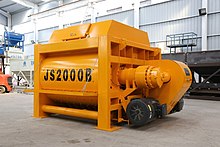Term: Concrete plant
**Types of Concrete Plants:**
– Concrete plants can be classified as dry mix plants or wet mixing plants.
– They can be categorized as stationary concrete plants or mobile concrete plants.
– Dry mix plants use weigh batchers for sand, gravel, and cement, while wet mix plants combine ingredients at a central location.
– Mobile batch plants are portable and allow batching at various locations.
– Stationary concrete plants are designed for high-quality, efficient concrete production.
**Concrete Plant Varieties:**
– **Dry Mix Concrete Plant:**
– Also known as a transit mix plant.
– Ingredients are weighed and discharged into a truck through a chute.
– Water is metered and added during transportation to the jobsite.
– **Wet Mix Concrete Plant:**
– Combines ingredients at a central location.
– Offers a more consistent mixture in a shorter time.
– Prevents premature setting by agitating the concrete during transportation.
– **Mobile Concrete Plant:**
– Also known as a portable concrete plant.
– Highly productive, reliable, and cost-effective.
– Allows batching at different locations.
– **Stationary Concrete Plant:**
– Designed for high-quality concrete production.
– Provides high output, efficiency, stability, and specification.
**Applications and Market Trends:**
– Used for ready mix, civil infrastructure, and precast applications.
– The global Ready Mix Concrete (RMC) market was valued at US$394.44 billion in 2017 and is expected to reach US$624.82 billion by 2025.
– Ready mix concrete plants have higher requirements for durability, reliability, safety, and environmental protection.
– Precast concrete batching plants offer safer construction, lower costs, and high-quality products compared to on-site pouring.
**Environmental Impact and Regulations:**
– Municipalities in urban areas are concerned about pollution from concrete batching plants.
– Absence of suitable dust collection systems in cement silos is a major source of particulate matter emissions.
– Regulations and guidelines are enforced to control emissions and pollution from concrete plants.
– Compliance with environmental standards, including dust collection systems and water runoff management, is necessary.
**Air Quality and Community Engagement:**
– Particulate matter emissions from concrete plants contribute to air pollution.
– Proper dust collection systems can help reduce emissions and improve air quality.
– Engaging with local communities is essential to address concerns related to concrete plants.
– Transparency in operations, communication with residents, and community feedback can help improve environmental practices at concrete plants.
This article needs additional citations for verification. (October 2012) |
A concrete plant, also known as a batch plant or batching plant or a concrete batching plant, is equipment that combines various ingredients to form concrete. Some of these inputs include water, air, admixtures, sand, aggregate (rocks, gravel, etc.), fly ash, silica fume, slag, and cement. A concrete plant can have a variety of parts and accessories, including: mixers (either tilt drum or horizontal, or in some cases both), cement batchers, aggregate batchers, conveyors, radial stackers, aggregate bins, cement bins, heaters, chillers, cement silos, batch plant controls, and dust collectors.

The heart of the concrete batching plant is the mixer, and there are many types of mixers, such as tilt drum, pan, planetary, single shaft and twin shaft. The twin shaft mixer can ensure an even mixture of concrete through the use of high horsepower motors, while the tilt mixer offers a comparatively large batch of concrete mix. In North America, the predominant central mixer type is a tilt drum style, while in Europe and other parts of the world, a twin shaft mixer is more prevalent. A pan or planetary mixer is more common at a precast plant.
Aggregate bins have 2 to 6 compartments for storage of various sand and aggregate (rocks, gravel, etc.) sizes, while cement silos are typically one or two compartments, but at times up to 4 compartments in a single silo. Conveyors are typically between 24 and 48 inches wide and carry aggregate from the ground hopper to the aggregate bin, as well as from the aggregate batcher to the charge chute.

The aggregate batcher, also named aggregate bins, is used for storage and to batch the sand, gravel and crushed stone of the concrete plant. There are also many types of aggregate batchers, but most of them measure aggregate by weighing. Some use a weighing hopper, some use a weighing belt.
The cement silos are indispensable devices in the production of concrete. They mainly store bulk cement, fly ash, mineral powder and others. There are three types of cement silos: bolted cement silos, horizontal cement silos and integrated cement silos. Integrated cement silos are made in factories, and can be used directly. Bolted cement silos are bolted for easy installation and removal. Horizontal cement silos have lower requirements on foundations and can be transported by truck or flatbed without disassembly.

The screw conveyor is a machine to transfer the materials from the cement silos to the powder weighing hopper.

Concrete plants use the control system to control the working of the machine. Concrete batch plants employ computer aided control to assist in fast and accurate measurement of input constituents or ingredients. With concrete performance so dependent on accurate water measurement, systems often use digital scales for cementitious materials and aggregates, and moisture probes to measure aggregate water content as it enters the aggregate batcher to automatically compensate for the mix design water/cement ratio target. Many producers find moisture probes work well only in sand, and with marginal results on larger sized aggregate.

